

Images and captions by Farish Noor (www.othermalaysia.org)
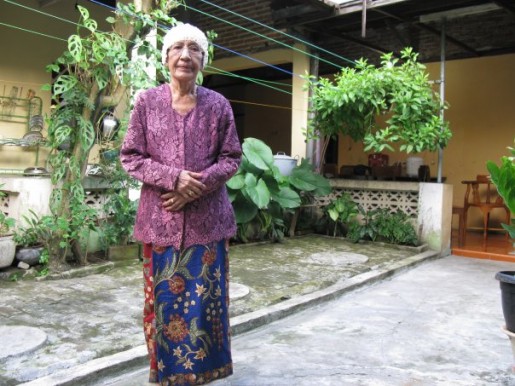
‘…a Javanese-Arab peranakan woman in Kudus, dressed in her finest. Note that the colours of the sarong also conform to traditional styles and tastes of the Arab Peranakans: Deep reds, dark blues, vermillion, scarlet etc.’
In conjunction with last weekend’s Art for Grabs fair at the Central Market Annexe political scientist and historian Farish Noor delivered another of his occasional lectures on Southeast Asian history.
The commercial atmosphere of the fair was an apt environment for his talk on ‘Batik as a Trans-Cultural Signifier.’ Unfortunately for Malaysia’s plummeting GDP no entrepreneur had set up a batik stall that day. They would have likely made a killing because Farish certainly seemed to have his audience sold on batik’s contemporary relevance.
BATIK AS BAHASA
Fresh back from fieldwork in Indonesia, Farish argued the case for batik to be understood as a trans-cultural lingua franca with latent political power. Employing an approach he calls “subaltern history”[1] Farish highlighted the cultural intermixing made physical in the medium of batik.
Farish’s talk was cast as an attempt to contrast the historical study of material cultures against elite histories. While the ‘hard’ politics of the latter are often favoured over the ‘soft’ politics of the former, Farish argued that if you get your soft politics wrong you won’t get your hard politics right.
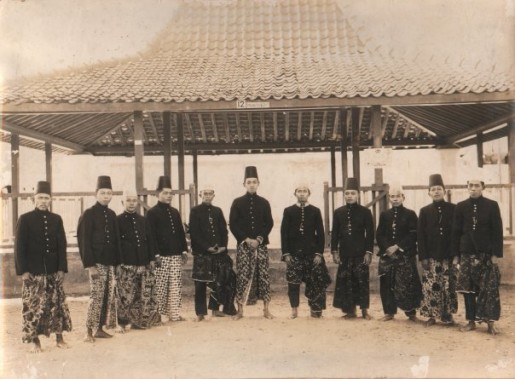
‘…a group of Surakarta nobles all dressed in court dress, and wearing the right sort of Kain Panjang with motifs and symbols associated with the court of Solo…’
Batik was a mode of communication, much like any other fashion, which through its symbols allowed the wearer to display status, cultural affinity, age, virginity, and mood, among other things. The use of batik as everyday attire by a wide range of Southeast Asian humanity spanning class, gender, ethnicity, and geography has made it attractive for someone such as Farish who seeks to valorise what unites rather than divides us.
In batik fabric over the centuries we can encounter Javanese, Hindu, Buddhist, Chinese, Dutch, and Arab influences in the motifs and overall design employed. Peranakans of Arab, Chinese, and Indian descent would favour certain symbols and colours. Batik was worn by royalty, commoners, and even gods. As testimony to the latter, the audience was treated to pictures of a Krishna wayang puppet garbed in batik, and a Jesus from a wayang kristen, similarly adorned with a royal parang motif.
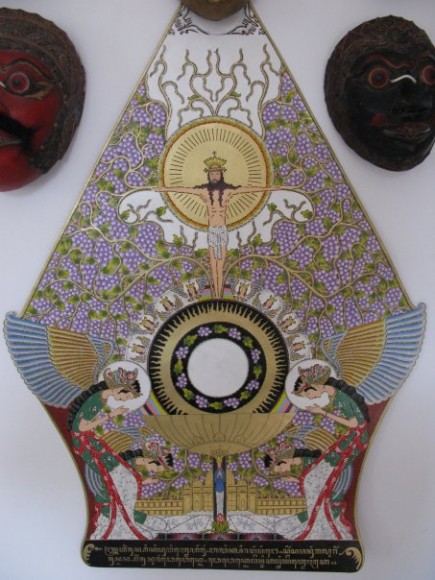
‘And not only Hindu Gods wore batik, but the Prophets of the Abrahamic faith too. Here is a kawon from a Wayang Kristen.’
Farish’s presentation was less of a text-heavy lecture and more of a guided visual tour. Besides electronic images of antique and contemporary photos of batik-clad Nusantarans Farish also exhibited a number of batik pieces from his personal collection. A rare child’s batik sarong was displayed and the meaning of protective wards imprinted on this and other pieces was explained. [Farish has been kind enough to let us reproduce some of his images and captions here].
Batik designs ranged from complex cosmologies to popular images of the times which captured the fancy (or marketing savvy) of the village women who laboured over their composition. From batik porselen which borrows Chinese porcelain motifs to a batik Belanda entirely inspired by art nouveau, changing times and cultural contacts were reflected in batik designs. Farish contended that these aspects of batik allow the historically minded a glimpse of life from the perspective of their creators, these village craftswomen. In this sense these batik still communicate across large spans of time as graphic documents.
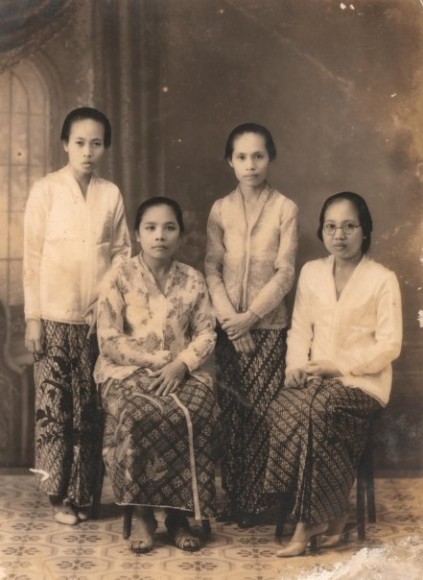
‘But Batik also transcended the boundaries of class and here is a shot of a group of Javanese girls on a day out; all of them wearing kain panjangs with typical central Javanese motifs too.’
POLITICISING BATIK
If batik wear was so ubiquitous in Southeast Asian life, how is its present diminished use to be explained? Farish offered some fragments to consider, and it is here that the culture of batik dress becomes politicised, first by colonialism, then by its successor state.
Some European colonists took to wearing batik, but the colonial order of the East Indies depended upon gradated race privilege, and the wearing of batik by Europeans evoked fears of miscegenation. Sumptuary laws banned its use amongst Europeans and replaced it with white-coloured western dress. One of the reasons motivating this may have been the desire to segregate European men from native women [2]. Increasing European political, and consequently cultural, influence may account for batik’s decline amongst first Asian men, and far slower, amongst Asian women.

‘In this photo a typical peranakan couple is seated: The man is dressed in modern (i.e. western) dress while his wife in Peranakan dress. It is important to note that batik allowed all the peranakan communities to claim a space and place for themselves here in southeast Asia, and that is why it is seen as traditional dress by ALL communities…’
Imports of European-made batik to the Indies provoked the proto-nationalist association of Asian batik traders, Sarekat Dagang Islamiyah (Islamic Traders’ Association), to launch a boycott. The SDI had influence on both Soekarno and the formation of the Partai Komunis Indonesia [3].
Farish himself provided the example of being expelled from KLCC for wearing a batik sarong. Similarly, I know a gentleman involved in rural education in Kedah who was refused entrance to visit our former prime minister on account of wearing a baju melayu and sarong. He was informed that he was inappropriately attired to be received by the country’s top civil servant and president of the Malay nationalist party.
These two elite venues in Malaysia, the prime minister’s office and a prime minister’s vanity project, proved hostile to customary uses of indigenous cloth, even though ironically there are shops in KLCC that retail batik as a commoditised form of the Malaysian experience.

‘A pair of sweet peranakan babes on a day out in Singapore in the 1950s. Note that the sarongs they are wearing seem to be batik imported from North coast Java, probably Pekalongan or Kedungwuni.’
COMMENTARY
If I read him correctly, Farish hopes to lionise batik as a cultural basis for political community. Batik has been politicised, but in a restrictive rather than inclusive manner. Other than his personal example Farish did not suggest concrete avenues for harnessing the power of batik. Perhaps there is scope for performative trangressions of unwritten taboos by employing batik dress in public spaces. He did suggest that if batik were to be liberated from its political shackles it should be the thing that unites us.
Unity is a project that carries political tones, even if it is not advanced as a project of state. Yet, it is one thing to propose future unity via batik, it is another to read such political community into batik’s history. I wonder if his emancipatory concerns lead Farish to propose “unity,” which is implicitly political, rather than “commonality,” which is not necessarily political, but could be one result of a de-fused politicisation [4].
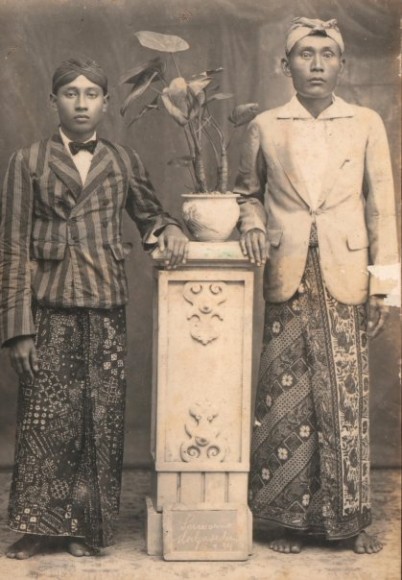
‘The aristocracy were wont to keep to their batik as well, despite the adaptations that came through Westernisation. This pair of dapper fellows combine both, and the bow tie is a rather nifty touch methinks…’
There is a risk for the listener of mistaking the message of unity (or commonality) for equality. The common medium of this printed cloth was used to communicate differences in power, wealth, and culture. At the same time, while these differences existed, ethnic affinity in particular was not politicised in the divisive manner experienced today in Malaysia, nor was the wearing of lower body batik kain seen as potentially embarrassing for males, or an affront to the masculine power of high office. It is tempting to read the trangressive entry of a man dressed in a batik sarong into the Twin Towers as a challenge to phallocentric ambition.
Yet, the political potential of batik was underlined by the timing, however unintentional, of the talk. In a week where fashion policing made it criminal to wear black, it became clear that a simple act of dress, in the right context, can have political impact in Malaysia today.

(YSL)
~
NOTES
[1] “Subaltern history” does not necessarily mean an alternative history from below, although it has come to carry such a connotation. ‘Subaltern’ originally referred to a subordinate military officer. The term was employed by Italian communist Antonio Gramsci as a substitute for ‘proletariat’ in his Prison Notebooks in order to bypass Fascist censors. The militancy communists hope to inspire in the working class probably informed his choice of the term. Influenced by Gramsci, the Subaltern Studies group of historians employed this term in their attempts to challenge elite nationalist historiographies of South Asia. This group expanded beyond a concern with the industrial working class to include peasants, women, and other ‘voiceless’ agents of history. With the professionalisation of ‘post-colonial studies’ subaltern historiography has become unanchored from Marxist/Maoist concerns. The inflection favoured by Farish Noor appears to be towards tendentious historical retrievals geared to promoting a liberal-democratic modernist multi-culturalism in Malaysia. Like the original Subaltern Studies group these retrievals are juxtaposed against an elite nationalist history that promotes narrow communalist concerns.
Interested readers can refer to the works of Ranajit Guha and Gayatri Chakravorthy Spivak, although be warned, Spivak is not for the academically faint hearted!
[2] An insightful text in this regard is Ann Laura Stoler’s Race and the Education of Desire (Duke University Press, 1995), which challenges the Eurocentrism of Michel Foucault’s History of Sexuality with the case of racialised sexual relations in the Netherlands East Indies.
[3] A semi-fictionalised account of one of the SDI’s founders, Tjokroaminoto, and the SDI itself can be found in Pramoedya Ananta Toer’s Buru Quartet.
[4] How does batik measure up to, for example, print capitalism in laying the grounds for an “imagined community” (ala Benedict Anderson)?
Sorry, the comment form is closed at this time.
Thank you YSL (ever the fashion guru!)
having missed the event, I am glad that you have provided those who are not there with such a detailed analysis of the talk. Keep up the good work. Thanks again!
Thanks, Karen!
[I’ve updated the post with captions from Farish’s Facebook photo album, should give those of you who missed it a better feel for the talk].
– Shao Loong
These two elite venues in Malaysia, the prime minister’s office and a prime minister’s vanity project, proved hostile to customary uses of indigenous cloth, even though ironically there are shops in KLCC that retail batik as a commoditised form of the Malaysian experience.
Shame! It’s a really nice feeling whenever I see Javanese men go around in batik sarong.
Hey, we should start a wear batik movement! And I don’t mean the collared shirt variety people normally wear to casinos or Majlis Pelancaran Something Something. Besides the motifs are a little tasteless.
Btw, love the idea of challenging our phallo-centric twin erections :) It’s not gender-f**king or cross dressing, but it certainly is a subtle transgression that is just as powerful.
Simon, I agree that the lower-body batik is where the provocation value is at. Coincidentally, almost all my favourite sarongs have gone threadbare at the same time. Need a re-supply, so maybe we should go batik shopping? Only the classy stuff please, of course. :)
Hmm, probably perfect if one wears a batik purchased from KLCC itself. Though, that’s probably not value for money.
hahaha done deal Shao.
LOL… sorry, I just notice Karen has pointed out the impeccable sartorial taste lodged in your initials, YSL.
>ahem< Yes, initials…old joke. Luckily I never took a liking to that particular designer or else I’d never live it down. Waaay, too blingy.
Initials aside, although, there is a beautiful symmetry there, I really enjoyed this piece Shao. And am kicking myself that I seemed to have missed such an amazing week of events and openings!
I-Lann if you are listening, please can you comment, write more on your take on batik and its impact in your work? There is just so much here that we can explore!
Batik is MUCH harder to physically DO than i ever thought.
Many thoughts. Hmmm will try put something logical down soon, just super busy right now. I will though because its a medium I would like to see find some kind of revival in the contemporary arts.
love this article on batik.
had no idea you can get booted out of public areas for a batik sarong. sheesh what a crime!
i agree with a batik movement. contemporary batik design still at its infancy stage and strongly agree that batik should be in contemporary arts…people need more batik exposure and yes no more batik for majlis pelancaran
love to read more on batik! would like to know more about the significance of the motifs too.
Sharinaz – Farish recommended “Fabric of Enchantment: Batik from the North Coast of Java” by Rens Heringa and Harmen Veldhuisen (Weatherhill, 1997).
I-Lann, I’m sure, can recommend many, many resources, although she’s crazy busy right now. :)
Hi Shao,
May I know where I can get a copy of his lecture or essay: Batik as a Trans-Cultural Signifier.?
I searched in theothermalaysia website but couldn’t find it.
Thanks,
Emelia